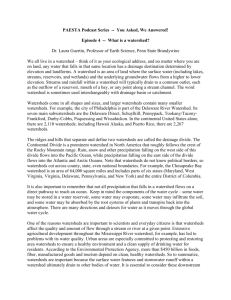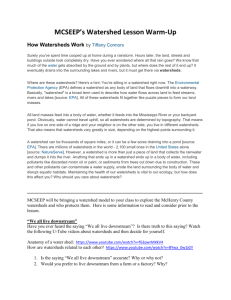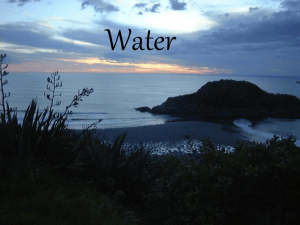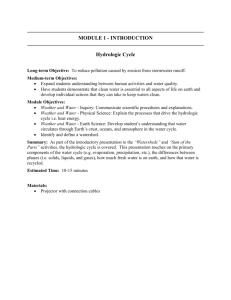Tracking Workgroup August 2014 Minutes (draft)
advertisement
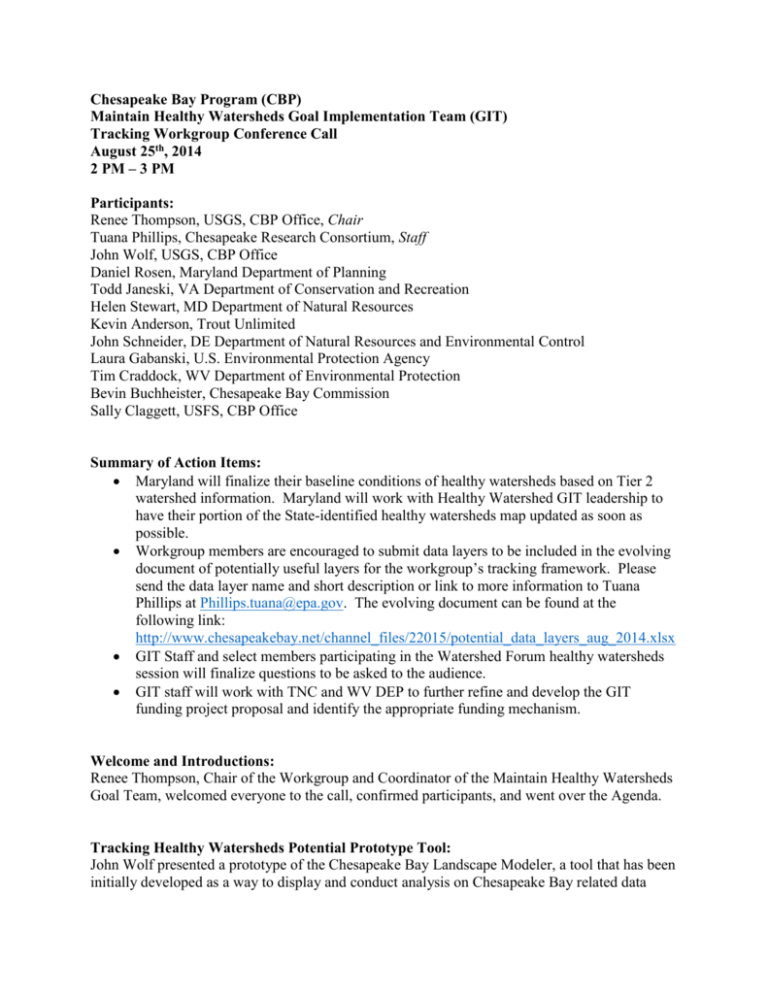
Chesapeake Bay Program (CBP) Maintain Healthy Watersheds Goal Implementation Team (GIT) Tracking Workgroup Conference Call August 25th, 2014 2 PM – 3 PM Participants: Renee Thompson, USGS, CBP Office, Chair Tuana Phillips, Chesapeake Research Consortium, Staff John Wolf, USGS, CBP Office Daniel Rosen, Maryland Department of Planning Todd Janeski, VA Department of Conservation and Recreation Helen Stewart, MD Department of Natural Resources Kevin Anderson, Trout Unlimited John Schneider, DE Department of Natural Resources and Environmental Control Laura Gabanski, U.S. Environmental Protection Agency Tim Craddock, WV Department of Environmental Protection Bevin Buchheister, Chesapeake Bay Commission Sally Claggett, USFS, CBP Office Summary of Action Items: Maryland will finalize their baseline conditions of healthy watersheds based on Tier 2 watershed information. Maryland will work with Healthy Watershed GIT leadership to have their portion of the State-identified healthy watersheds map updated as soon as possible. Workgroup members are encouraged to submit data layers to be included in the evolving document of potentially useful layers for the workgroup’s tracking framework. Please send the data layer name and short description or link to more information to Tuana Phillips at Phillips.tuana@epa.gov. The evolving document can be found at the following link: http://www.chesapeakebay.net/channel_files/22015/potential_data_layers_aug_2014.xlsx GIT Staff and select members participating in the Watershed Forum healthy watersheds session will finalize questions to be asked to the audience. GIT staff will work with TNC and WV DEP to further refine and develop the GIT funding project proposal and identify the appropriate funding mechanism. Welcome and Introductions: Renee Thompson, Chair of the Workgroup and Coordinator of the Maintain Healthy Watersheds Goal Team, welcomed everyone to the call, confirmed participants, and went over the Agenda. Tracking Healthy Watersheds Potential Prototype Tool: John Wolf presented a prototype of the Chesapeake Bay Landscape Modeler, a tool that has been initially developed as a way to display and conduct analysis on Chesapeake Bay related data layers. The Tracking Workgroup could maybe use this tool toward the Healthy Watersheds Goal to: Sustain state-identified healthy waters and watersheds recognized for their high quality and/or high ecological value. For more information on the Landscape Modeler and this project: https://marketplace.arcgis.com/listing.html?id=58e5b2fe5aaa4aa782175c334734e0a9 The prototype has been developed using the ESRI Landscape Modeler, which is a suitability analysis planner to assist researchers in determining which locations are best suited for certain uses. It allows users to customize specific environmental factors and weighting to compare various data inputs and visualize them on the landscape. The Chesapeake Bay Landscape Modeler will include various Chesapeake Bay Program and Mid-Atlantic state layers. This will give users the ability to select two or multiple layers of interest to produce their own maps with a range of composite scores. Eventually, USGS CBP Office will incorporate map layers and other features on Chesapeake Stat: http://stat.chesapeakebay.net/ . The tool works on ArcGIS online. Other discussion points: If this tool ends up being used by the Tracking Workgroup, it will not be used to track the baseline conditions of healthy watersheds. Instead, it will be most likely used to track healthy watershed protection in a more standardized manner. This is in line with the Workgroup’s charge. It is important to track a consistent, periodic cycle (e.g., every 5 years), as well as tracking what is being done to ensure that the watersheds are protected (e.g. conservation easements, controlling of non-point source pollution, connectivity, and enhancement of healthy watersheds). Additional data related to not only urban development threat but also energy development should also be considered. There is an interagency group in Maryland and has developed a matrix of data related to Water Resources Registry work. This may be useful for this group as well. It was reiterated that the workgroup does not want to create undue burden for the states, and will use layers that will be or already have been developed. Healthy Watersheds GIT staff have developed an evolving document of potentially useful documents, which can be found at the following link: http://www.chesapeakebay.net/channel_files/22015/potential_data_layers_aug_2014. xlsx . Workgroup members are encouraged to share the document with other groups and contribute to the document by contacting Tuana. Watershed Forum: Healthy Watersheds Session The Forum will take place at the USFWS National Conservation Training Center in Shepherdstown, WV, from Sept 26-28. The Healthy Watersheds GIT is organizing a session, in which GIT speakers will highlight some of the work of the GIT as well as the Local Engagement and Tracking Workgroup. Ideally though, the session will be an opportunity to reach out to a broader audience of watershed professionals to gain input into our key workgroup task: how to track and report the identification, health and protection status of State-identified healthy watersheds. Renee proposed a few example questions that can be asked to audience members during the session: Besides Tracking Land Protection, what other indicators should we investigate to help evaluate watershed health? Who are the key stakeholders that we should invite to be part of this discussion? Additional discussion points related to Watershed Forum stakeholder input: Think more broadly than the healthy watersheds outcome. What indicators are common across large landscapes that could be utilized? Should we be monitoring watershed protection (e.g. strength of local policies, level of land use regulation, specific presence of lack of a policy, etc.?) USGS at the CBP office develops a layer of vulnerability to development. MDP, too, has its own land use stability model. What are other ways in which agencies and organizations are gaging development pressure? What can we do to incentivize reporting from municipal, local, and state governments? Or is that something we have to take on ourselves? Could 319 plans be used to track protection? States are in the process of rewriting their 319 plans, and they are paying more attention to protection. WV, for instance, is working on developing a protection plan for Backcreek. This plan includes conservation easements, farmland conservation, and natural stream restoration projects. Backcreek was chosen in particular because it is a community with an active watershed organization and good community base. GIT funding: Identifying Additional Healthy Watersheds The Chesapeake Bay Program has awarded over $850K to Goal Implementation Teams for projects related to their outcomes. One of the approved projects is $50,000 to identify additional State Healthy Watersheds. After consultation with GIT leadership, it has been determined that this initial money may be best spent in WV to further develop the Watershed Assessment Pilot Project that was presented at the December 2013 Healthy Watersheds GIT membership meeting: http://www.chesapeakebay.net/channel_files/21119/wv_chesapeakebayprogram_20131219.pdf Renee recently spoke with our WV team member, Tim Craddock as well as with the TNC principal Project Manager regarding this idea and both are receptive to expanding the pilot project with the aim of creating a more robust State-identified Healthy Watershed GIS layer for the Chesapeake Bay Watershed portion of West Virginia. Discussion: should the Tracking Workgroup make a recommendation to the Healthy Watersheds GIT that this is an appropriate use of the awarded $50,000 dollars? Members agreed that this idea is an appropriate use of the awarded money, as long as the project results in additional healthy watersheds being identified and there is a seat at the table for the GIT to learn about the process. As the project develops, it might be worth using a disclaimer. TNC is leading the work on behalf of the state, but we want to make sure everyone is welcome and kept in the loop. Other things to consider: how is drilling monitored? How will climate change be incorporated into the assessment?


